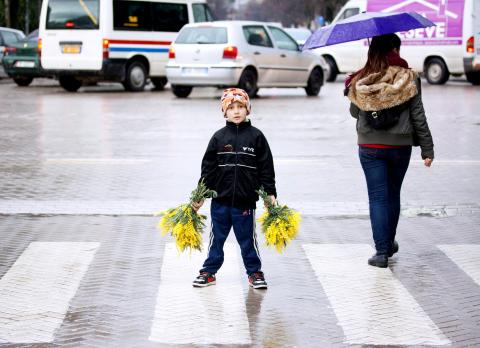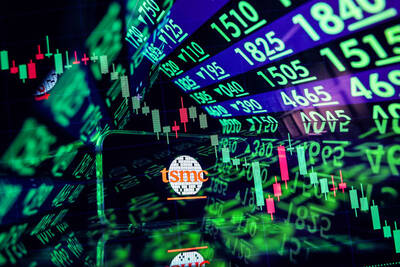Like miniature pompoms bursting with color and fragrance, mimosa flowers turn the hills around France’s perfume capital, Grasse, a golden yellow for a couple of fleeting weeks each year.
Though they fade fast — and must be processed as soon as they are harvested — a second life awaits these harbingers of spring as a prized ingredient in some of the world’s most coveted scents.
“Mimosa is still a perfumer’s mainstay,” said Sebastien Plan of Robertet, a major international supplier of the raw ingredients that go into perfumes.

Photo: AFP
Mimosa’s heady fragrance, which enjoyed a heyday from the 1950s through the 1970s, is used in tiny amounts today.
Modern perfumes tend to be “subtler, with a good, clean and smooth” effect, Robertet said.
Yet it can still “become a perfume’s secret ingredient,” he said.
“Mimosa has a fresh, floral, slightly powdery, almost honeyed aspect, which blends with the green scent of the stems,” he added, admitting a preference for the stronger wild variety.
From a harvest of about 40 tonnes of flowers, Robertet produces about 400kg of a rock-like substance called “concrete” — which is in turn purified into about 100kg of “absolute.”
Jean-Pierre Roux, the boss of the Grasse perfumery Galimard, pays tribute to this “symbol of the Grasse terroir” by distilling the flowers into a refreshing cologne, popular with visitors who come to see the mimosas in bloom.
Grasse, situated on the French Riviera, has long been France’s perfume capital.
Fields of Provence roses and jasmine sprung up around the area in the 17th century when local tanners started scenting their leather products — especially gloves — with fragrant floral oils, which are still used today to make luxury perfumes such as Chanel No. 5.
Galimard’s perfumer Caroline de Boutiny said that its mimosa scent is more popular with older customers than with the young.
The strong mimosa absolute is little used in modern fragrances, but it can “lend weight to a composition with its honeyed and powdered notes,” she said.
Luxury perfume brands Kenzo and Guerlain use it for this quality in their toilet waters, de Boutiny said.
The mimosa tree arrived in France from Australia in the 19th century as a decorative plant for gardens and still forms a luxurious forest on the Tanneron hills west of Grasse.
“Mimosa is like velvet,” said Gilbert Vial, an 85-year-old “mimosist” who has never left the town of Tanneron.
This year, the blossoms have only flowered for a brief period, he said.
To lengthen the season, local mimosa growers first plant the mirandole variety, which flowers in December and January, followed by the rustica and gaulois varieties, which bloom in February and March.
Vial, whose family has sold mimosa bouquets for three generations, has little time for the secret world of the perfume industry.
These days he can no longer even discern the scent of mimosa, even as it pervades his small village shop.
Yet the declining use of the flowers in the fragrance industry is being felt here.
Vial’s 60-year-old son is the last in line to harvest the steep slopes of the family’s land.
“Before the frost of 1956, thirty families grew mimosa in Tanneron. Today there are just three or four of us,” he said. Many perfumers prefer synthetic ingredients that closely resemble mimosa and are less onerous to produce.
Globalization of production has also affected French growers, who now face competition from cheaper producers in far-flung countries.
Even some Grasse suppliers, like Robertet, today import cheaper mimosa “concrete” from Indian suppliers.
“Previously, six train cars left five days a week from Cannes heading to England,” Vial said. “Then, there was no other source of flowers in winter. Nowadays, flowers arrive from all over the world.”

Taiwan Semiconductor Manufacturing Co (TSMC, 台積電) last week recorded an increase in the number of shareholders to the highest in almost eight months, despite its share price falling 3.38 percent from the previous week, Taiwan Stock Exchange data released on Saturday showed. As of Friday, TSMC had 1.88 million shareholders, the most since the week of April 25 and an increase of 31,870 from the previous week, the data showed. The number of shareholders jumped despite a drop of NT$50 (US$1.59), or 3.38 percent, in TSMC’s share price from a week earlier to NT$1,430, as investors took profits from their earlier gains

In a high-security Shenzhen laboratory, Chinese scientists have built what Washington has spent years trying to prevent: a prototype of a machine capable of producing the cutting-edge semiconductor chips that power artificial intelligence (AI), smartphones and weapons central to Western military dominance, Reuters has learned. Completed early this year and undergoing testing, the prototype fills nearly an entire factory floor. It was built by a team of former engineers from Dutch semiconductor giant ASML who reverse-engineered the company’s extreme ultraviolet lithography (EUV) machines, according to two people with knowledge of the project. EUV machines sit at the heart of a technological Cold

Taiwan’s long-term economic competitiveness will hinge not only on national champions like Taiwan Semiconductor Manufacturing Co. (TSMC, 台積電) but also on the widespread adoption of artificial intelligence (AI) and other emerging technologies, a US-based scholar has said. At a lecture in Taipei on Tuesday, Jeffrey Ding, assistant professor of political science at the George Washington University and author of "Technology and the Rise of Great Powers," argued that historical experience shows that general-purpose technologies (GPTs) — such as electricity, computers and now AI — shape long-term economic advantages through their diffusion across the broader economy. "What really matters is not who pioneers

TAIWAN VALUE CHAIN: Foxtron is to fully own Luxgen following the transaction and it plans to launch a new electric model, the Foxtron Bria, in Taiwan next year Yulon Motor Co (裕隆汽車) yesterday said that its board of directors approved the disposal of its electric vehicle (EV) unit, Luxgen Motor Co (納智捷汽車), to Foxtron Vehicle Technologies Co (鴻華先進) for NT$787.6 million (US$24.98 million). Foxtron, a half-half joint venture between Yulon affiliate Hua-Chuang Automobile Information Technical Center Co (華創車電) and Hon Hai Precision Industry Co (鴻海精密), expects to wrap up the deal in the first quarter of next year. Foxtron would fully own Luxgen following the transaction, including five car distributing companies, outlets and all employees. The deal is subject to the approval of the Fair Trade Commission, Foxtron said. “Foxtron will be